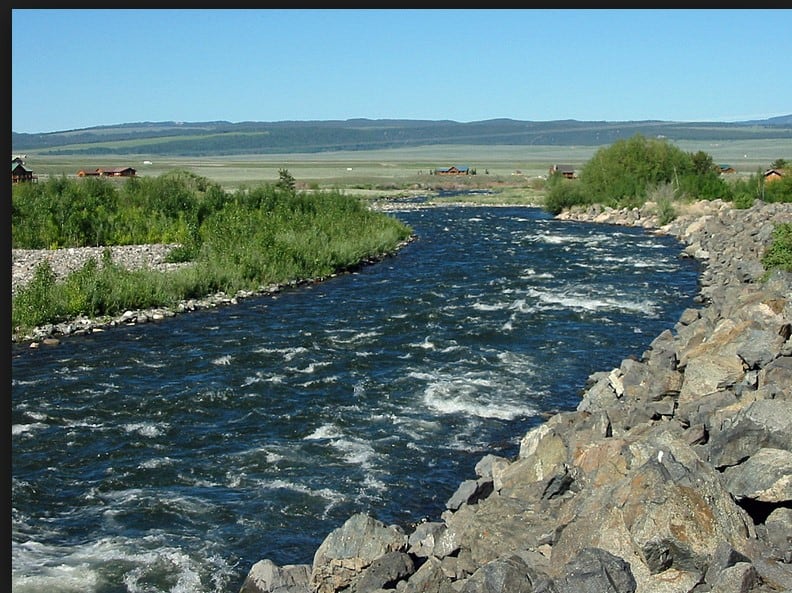You see it, but you aren’t prepared to believe it. The enormity of eighty million tons of rock sliding down a mountain in barely 20 seconds is almost beyond anyone’s comprehension.
 |
| West entrance to Madison Canyon |
Eighty million tons? That’s enough rock and debris to pave a road three feet thick from West Yellowstone, not far from where the slide occurred, all the way to New York City.
 |
| View of the landslide area from the visitor center |
Earlier this month I drove through the Earthquake Lake Geologic Area west of Yellowstone to learn something about what happened during that summer night 53 years ago. There were few other cars on the road as I passed through on my solitary sojourn, no one to disturb the apparent tranquility of the day.

A magnitude 7.5 event named the Hebgen Lake Earthquake shook the ground to shreds the night of August 17, 1959, triggering the massive slide. Fault lines miles long ripped into the crust and permanently altered not only the landscape but also the lives of those who were camped along Hebgen Lake and the Madison River canyon. The ground shuddered, a mountain slid into the canyon, and the river was dammed by the fallen rock.
 |
| Visitor center (center of image) is constructed on the edge of the landslide |
Over the next several weeks the water rose about nine feet per day in the narrow canyon. Within three weeks the new lake measured five miles long and in places was 190 feet deep. Fifty–three years later the skeletal tops of drowned trees still pierce the water’s surface.
 |
| View downstream toward slide area; submerged trees in Quake Lake (Madison River) |
Twenty eight people died and nineteen remain buried beneath the mountain of slide debris. It was the most devastating modern geologic disaster to occur in the Rocky Mountains.
Along a section of the 125–mile long crustal weakness called the Hebgen Lake fault block, the earth dropped to form this 20–foot cliff.
 |
 |
| 20-foot cliff formed by crust dropping along Hebgen Lake fault block |
I had read about the Hebgen Lake quake some time ago, learned about it in school, and seen aerial photos in various books and websites. Still, as I stood there in the chilly autumn sunshine and looked across the highway at a mountainside that doesn’t exist anymore, I was stunned by the enormity of it all. It took more than a moment for me to realize what I was looking at, more than a few moments for it all to sink in to my brain. This is not some mining company’s gash in the ground bulldozed to extract resources. This is nature in its rawest form.
 |
| View from visitor center towards slide area |
The earthquake, centered near Hebgen Lake, occurred around midnight, so no one really saw the mountain come down. It wasn’t until the new dawn broke that people started to realize the nature and extent of what had taken place. Over weeks and months following the devastation geologists began to piece together an explanation of what had happened to cause half of a mountain to fall.
Significant clues were the scattering on the ground of huge dolomite boulders that came to rest on the far edge of the slide, the composition of the slide debris, and the rock layers laid bare on the newly exposed southern wall of the canyon.
 |
| Within 20 seconds, this massive boulder was transported 1/2 mile across the canyon |
 |
| The other half of this mountain slid into the Madison River canyon |
 |
| Tilted beds of schist and gneiss were one clue in determining what happened |
On the southern wall of the canyon prior to the quake, layers upon layers of weak, ancient rocks such as amphibolites, gneisses, and schists were tilted toward the river at high angles. At the base of these rocks was a layer of harder dolomite that acted as a sort of buttress, shoring up the schist and gneiss layers like a brick propping up a deck of cards set on edge.
The earthquake shattered this delicate system of stone. The dolomite support was fractured, allowing the softer, weaker schist and gneiss layers to break through and slide down the mountain in one huge slumping mass.
Today, two massive dolomite boulders are found at roughly the same elevation as the dolomite ledge across the canyon from which they most likely originated. With inconceivable energy they were carried on the leading edge of the slide, suspended on a slurry of debris that was, for a fleeting moment in time, behaving more like a liquid than solid rock. Within the 20 seconds that the slide lasted these three–thousand–ton boulders traveled one half mile across the canyon.
 |
| Trail to memorial boulders – tilted beds in background are beyond the tip of the slide |
A plaque on one of the dolomite boulders is dedicated to those who lost their lives as a result of the Hebgen Lake earthquake. The fact that this is not only a fascinating geologic area but also someplace where people died because of that geology made me pause more than once and silently pay my respects to the tremendous power of nature.
 |
| The Madison River slowly reclaims its wild nature as it shapes its own path through the debris |
I hope you find your way to the Earthquake Lake Geologic Area some day. If you go in October like I did, you most likely will be the only one there.







